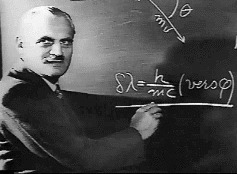Organisateurs: Christelle Bruni (CNRS/Université Paris Saclay, bruni@ijclab.in2p3.fr), Marc Simon (Sorbonne université, marc.simon@upmc.fr), Geneviève Loupias (Sorbonne Université, genevieve.loupias@upmc.fr), Fabrice Catoire (Université de Bordeaux, fabrice.catoire@u-bordeaux.fr), Andrew Mayne (Université Paris Saclay, andrew.mayne@u-psud.fr) |
| Division Physique Atomique et Moléculaire Optique, Division Accélérateurs |
Horaires: lundi 16h45 Salle Cécile DeWitt-Morette
|
Il y a 100 ans, en 1923, Arthur Compton expliqua l’allongement de la longueur d’onde des photons X ou gamma qu’il avait observé lors de leur diffusion par des cibles variées. Pour ce faire, il utilisa l’aspect corpusculaire de la lumière, apportant ainsi une preuve expérimentale à la dualité onde-corpuscule introduite par Planck et Einstein dans les années 1900.
100 years ago, in 1923, Arthur Compton explained the lengthening wavelengths of X-ray and gamma-ray photons he had observed being scattered by a variety of targets. To do this, he used the corpuscular aspect of light, providing experimental proof of the wave-corpuscle duality introduced by Planck and Einstein in the 1900s. He imagined the inelastic scattering of incident photons by electrons engaged in the target, and thus determined the lengthening of photon wavelengths [the so-called "Compton shift": Nobel Prize 1927]. In addition to its fundamental role in highlighting the corpuscular nature of light, the Compton effect is widely used to probe matter, and is proving indispensable in medicine in particular. Thanks to the increased performance of particle accelerators and lasers, it is also the basis for new sources of intense, monochromatic X-rays. More recently, non-linear effects induced by intense and brief UV or X-ray fields obtained by X-ray Free Electron Lasers (XFEL) have made it possible to revisit the Compton effect, opening up new perspectives. Finally, the Compton effect is also widely used in astrophysics and cosmology, either for observation (Compton telescope), or by generating distortions to probe the Universe. These various themes surrounding the Compton effect have been addressed during this mini symposium. |

 Il imagina la diffusion inélastique des photons incidents par les électrons engagés dans la cible et détermina ainsi l’allongement de la longueur d’onde des photons [déplacement dit « Compton » : prix Nobel 1927]. Outre son aspect fondamental mettant en évidence la nature corpusculaire de la lumière, l’effet Compton est largement utilisé pour sonder la matière et s’avère incontournable notamment en médecine. Grâce à la montée en performance des accélérateurs de particules et des lasers, il est également la base de nouvelles sources de rayonnement X intenses et monochromatiques. Plus récemment des effets non-linéaires induits par des champs UV ou X intenses et brefs obtenus par Lasers à Electrons Libres (dit XFEL pour X-ray Free Electron Laser) permettent de revisiter l’effet Compton et ouvrent de nouvelles perspectives. Enfin, il est également largement utilisé en astrophysique et en cosmologie par exemple soit pour l’observation (télescope Compton), soit en engendrant des distorsions permettant de sonder l’Univers. Ces différents thèmes autour de l’effet Compton ont été abordés lors de ce mini colloque.
Il imagina la diffusion inélastique des photons incidents par les électrons engagés dans la cible et détermina ainsi l’allongement de la longueur d’onde des photons [déplacement dit « Compton » : prix Nobel 1927]. Outre son aspect fondamental mettant en évidence la nature corpusculaire de la lumière, l’effet Compton est largement utilisé pour sonder la matière et s’avère incontournable notamment en médecine. Grâce à la montée en performance des accélérateurs de particules et des lasers, il est également la base de nouvelles sources de rayonnement X intenses et monochromatiques. Plus récemment des effets non-linéaires induits par des champs UV ou X intenses et brefs obtenus par Lasers à Electrons Libres (dit XFEL pour X-ray Free Electron Laser) permettent de revisiter l’effet Compton et ouvrent de nouvelles perspectives. Enfin, il est également largement utilisé en astrophysique et en cosmologie par exemple soit pour l’observation (télescope Compton), soit en engendrant des distorsions permettant de sonder l’Univers. Ces différents thèmes autour de l’effet Compton ont été abordés lors de ce mini colloque.